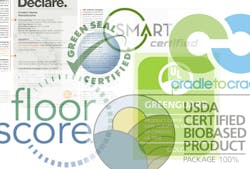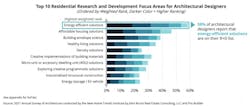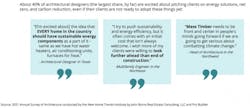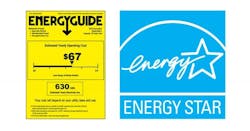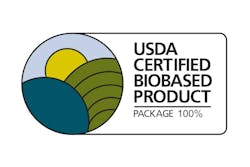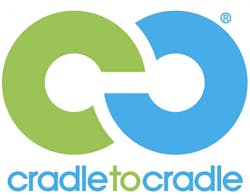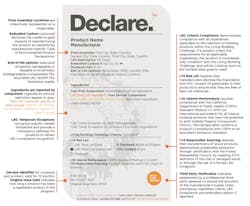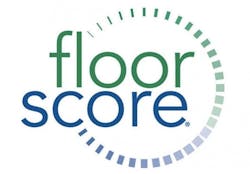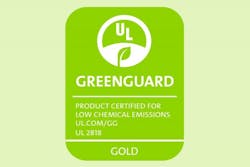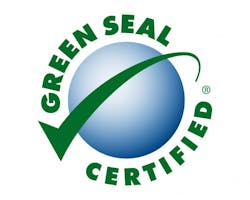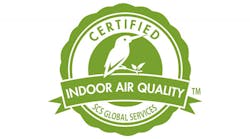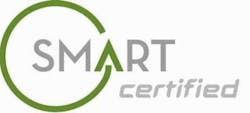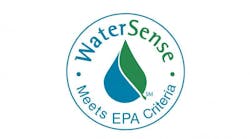9 Ecolabels (Other Than Energy Star) to Guide Healthier, More Sustainable Product Selections
If the increase in demand for healthier and more sustainable (i.e., greener) homes is to be believed, then so should the growing importance of including healthier and more sustainable building materials and products in new builds and renovations. The data says it should at least be taken seriously.
Realtors are reporting similar trends.
More than half of the National Association of Realtors’ surveyed membership described their clients as being “somewhat interested” in sustainability, and 65% said that “energy efficient promotion in listings” was “very or somewhat valuable.” Just about a quarter of homebuyers told their Realtors that they would pay more for a “high-performance home.” That share may ultimately prove higher (or lower) as 57% of respomndents said that they simply “didn’t know” if their clients would pay more.
Where Ecolabels Come In
For builders and remodelers interested in creating healthier, more sustainable homes—whether as a point of principle or response to the market—there may be a question of where changes need to be made.
One answer is the construction. Better air sealing will help, for instance, and there is plenty of efficiency to be found in advanced framing, a good example being raised heel roof framing.
Another answer is in using different (better?) materials and products. A good way to figure out what those materials and products are, is ecolabels.
READ MORE: Case Study: Cladding That Delivers Strength, Beauty, and Efficiency
An ecolabel is a voluntary indicator of environmental consciousness that manufacturers can attain for their products by meeting certain standards set forth by any number of overseeing organizations, some public and some private. What probably comes to mind is Energy Star.
Since its creation in 1992 by the Environmental Protection Agency, the Energy Star ecolabel has become a household name both figuratively and literally.
As of 2019, 91% of households reported recognizing the Energy Star label, and more than two thirds described the label as being at least “somewhat” influential in their product purchasing decisions, according to latest data from the EPA.
But as well known and widespread as the Energy Star name may be, it isn’t the only ecolabel around (and it doesn’t denote some of the attributes other ecolabels focus on). We’ve identified nine others worth knowing.
BioPreferred Program
Cradle to Cradle
Declare
FloorScore
GREENGUARD
Green Seal
Indoor Advantage
SMaRT Certified
WaterSense
BioPreferred Program
Started in 2011 by the U.S. Department of Agriculture, the BioPreferred program recognizes “biobased products,” which the Department recognizes as "derived from raw materials such as plants and other renewable agriculture, marine, and forestry materials" and "generally provide an alternative to conventional petroleum derived products and include a diverse range of offerings such as lubricants, detergents, inks, fertilizers, and bioplastics."
As of 2021, the program had certified 4,700 products from 930 companies, according to the USDA. Included among the categories in which building products have been recognized as BioPreferred are adhesives, roofing materials, composite panels (from structural wall to acoustical to countertops, etc), exterior paints and finishes, floor coverings, and more.
Backing Organization: USDA
Product Categories
Product Database
Information for Product Manufacturers
Cradle to Cradle
A label to indicate that a product “positively impacts people and the planet,” the Cradle to Cradle (C2C) Product Standard (currently available in bronze, silver, gold, and platinum designations) was first introduced in 2005 though was derived from principles laid out in the 2002 book Cradle to Cradle: Remaking the Way We Make Things from architect William McDonough and chemist Michael Braungart. While the standards are revised “at least every three years,” according to the Institute, the five basic principles guiding the standard are: material health, product circularity, clean air and climate protection, water and soil stewardship, and social fairness.
Included among the categories in which building products have been recognized as C2C certified are exterior materials (from windows to siding to doors, etc), drywall, insulation, certain electrical components (such as solar panels), and more.
Backing Organization: Cradle to Cradle Products Innovation Institute
Product Categories and Database
Fact Sheet
Cradle to Cradle Information for Product Manufacturers
Declare
Included among the categories in which building products have adopted the Declare label are flooring, windows, doors, structural materials (such as joists), and more.
Backing Organization: International Living Future Institute
Product Categories and Database
Information for Product Manufacturers
FloorScore
Specific to “hard surface flooring materials, adhesives, and underlayments,” FloorScore is a certification standard that denotes a product’s contribution to better indoor air quality, according to SCS Global Services, the program’s exclusive certifying body. The designation qualifies for a number of green building standards including LEED v4, WELL, BREEAM, CHPS, and Green Globes.
Included among the flooring materials that have been recognized by FloorScore are vinyl, engineered hardwood, bamboo, solid wood, and more.
Backing Organization: SCS Global Services (in partnership with the Resilient Floor Covering Institute)
Product Categories and Database
Information for Product Manufacturers
GREENGUARD
A creation of UL, a global safety certification company, GREENGUARD is a designation denoting low emissions from volatile organic compounds (VOCs), which are found in several building materials and contribute significantly to a home’s indoor air quality.
Earning GREENGUARD certification (also available is GREENGUARD Gold) requires that a product be “subject to a review of the manufacturing process and routine testing” to ensure it meets the emission limits set by UL. The certification’s criteria also serves as the basis for the LEED credit for low-emitting furniture.
Backing Organization: UL
Product Categories and Database
Information for Product Manufacturers
Green Seal
One of the first ecolabels ever available—introduced in 1989 and a founding member of the Global Ecolabelling Network—Green Seal represents a series of standards applied to products that have been “verified as safer for human health and the environment compared to similar products while delivering uncompromising performance,” according to the organization. To receive the designation, a product must meet several criteria such as limits for VOC emissions and particular ingredient inclusions—for instance, mercury, lead, and cadmium are prohibited above 100 parts per million—as well as adhere to stipulations on packaging, labeling, end-of-life management, and overall sustainability.
Included among the categories in which building products have earned the Green Seal certification are adhesives, paints, coatings, stains, sealers, and more.
Backing Organization: Green Seal
Product Categories and Database
Green Seal Information for Product Manufacturers
Indoor Advantage
Similar to FloorScore (and also a standard set by SCS Global Services), the Indoor Advantage (and Indoor Advantage Gold) certification is a designation denoting “low VOC emissions” for furniture and building materials. The certification is recognized by the EPA and qualifies as an EQ building credit for several building standards such as LEED v4, BREEAM, WELL Building, and Living Building Challenge.
Included among the categories in which building products have earned the Indoor Advantage certification are adhesives, paints, coatings, furniture, flooring, panels, and more
Backing organization: SCS Global Services
Product Categories and Database
Information for Product Manufacturers
SMaRT Certified
The SMaRT Certified designation denotes that a product—taking into account its full lifecycle, from creation to end—demonstrates “multiple environmental, social, and economic benefits,” according to The Institute for Market Transformation to Sustainability (MTS), the organization responsible for the certification and an American National Standards Institute-Accredited Standards Developer. It is one of the few ecolabels that also refers to a product’s “business benefits,” described as “cost savings, design innovation, product differentiation, long term customer relationships, (and) liability reduction.”
Backing Organization: MTS
Product Categories and Database
Information for Product Manufacturers
WaterSense
Like Energy Star, WaterSense is an EPA program and ecolabel, but instead of denoting energy efficiency it represents water efficiency. Specifically, the certification is reserved for products that “use at least 20% less water, save energy, and perform as well as or better than regular models,” according to the EPA.
Backing Organization: EPA
Product Categories and Database
Information for Product Manufacturers
